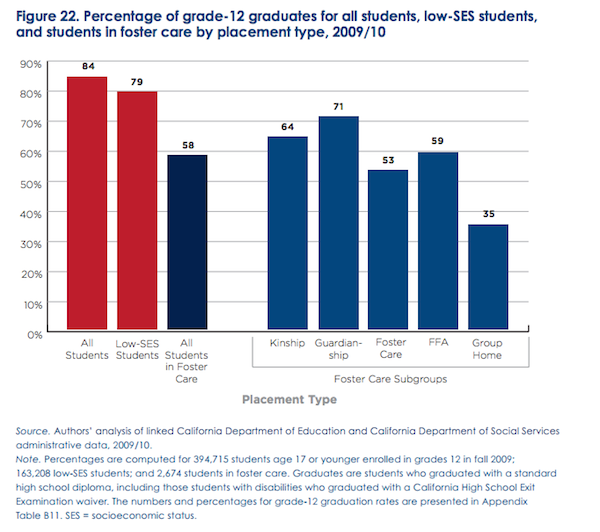Where foster kids live affects school performance, report says
Source: The Invisible Accomplishment Gap Written report
High schoolhouse seniors in foster care are much less likely to graduate than other low-income seniors, particularly if they are living in group homes.
 Source: The Invisible Achievement Gap Report
Source: The Invisible Achievement Gap Report
Loftier schoolhouse seniors in foster care are much less probable to graduate than other low-income seniors, especially if they are living in group homes.
Foster youth perform worse in school depending on where they are placed, such as group homes, and how long they stay in that location, according to a new report that reveals the impact of living atmospheric condition and other factors on the academic achievement of foster children.
The Invisible Achievement Gap, Part two follows an earlier written report that detailed the dismal bookish achievement of California'south 43,000 schoolhouse-aged foster youth.
In the latest written report, the researchers found that older foster students – particularly those who live in group homes or have experienced 3 or more foster placements in ane school year – accept the lowest bookish achievement of all foster youth.
Together, the two reports break new ground considering, as the authors note, footling has been known near the educational activity of youth in foster care "despite the state'due south legal responsibleness for these children."
Part 2 was released Th by the Center for the Future of Teaching and Learning at WestEd, a research system based in San Francisco, and the California Child Welfare Indicators Project, a data collaboration enterprise between University of California, Berkeley and the California Department of Social Services.
The report is "an invaluable tool" for school districts as they develop plans to improve the bookish accomplishment of foster youth, said Jesse Hahnel, manager of the National Center for Youth Law'southward Foster Youth Teaching Initiative.
About a third of foster students are placed in homes certified past private foster agencies, co-ordinate to the report. Close to one-third live with relatives. Among the remaining students in foster care, 15 pct are with legal guardians, 10 pct are in grouping homes and 8 percent are in state-licensed foster homes.
Relying on data from the 2009-x schoolhouse year, the report establish that 2-thirds of students living in group homes scored below basic or far below basic on the state'southward STAR math tests, and 61 percent scored that low in English language arts.
In addition, the researchers found that half of students who experienced iii or more foster placements in one schoolhouse year scored in those lesser two levels in English language, and 44 percent scored that low in math.
Graduation rates for loftier school seniors in foster care were also dismal, with but 35 percent of those living in group homes graduating, compared to 79 percent of other low-income seniors, according to the written report. Loftier school seniors who were living with relatives or with guardians were the most probable to graduate, only they still lagged behind students not in foster care. (Run across the graph.)
Foster youth are more likely to be diagnosed with a learning disability. (Click to enlarge) Source: The Invisible Achievement Gap, part 2
The researchers also constitute that:
- Only two-thirds of students in foster care – and just half of group abode students – stayed in one school for the entire school year, compared with ninety percent of other low-income students.
- Foster students are more likely to be diagnosed with a disability – particularly boys, older students, group home students, and students who take been in foster care for 3 or more years.
The report lays the arraign for the general lack of cognition near academic outcomes for foster youth on a lack of collaboration between the education and child welfare systems.
The ii systems practice non accept a shared definition of who is a foster child or unique educatee identifiers and so foster students' bookish progress can be tracked.
"Equally a event, the education needs of these students take been unstudied and unrecognized – peradventure leaving many already vulnerable students in foster care abaft behind their classmates in academic achievement," the study states.
Merely things are nigh to modify. The state will shortly be sending districts lists of the names of their foster students. Districts are then required to create a Local Control and Accountability Plan (LCAP) to target resources to foster youth and monitor their progress.
Hahnel says districts should use the data in the new report to help them target extra resources to the almost vulnerable foster students.
"All foster children need services, but permit'southward pay particular attention to youth living in group homes," he said. "In terms of prioritizing summer school or tutoring, districts demand to make sure that youth in group homes are accessing those services."
Child welfare agencies should also have notation, Hahnel said.
Although social workers generally see group homes as placements of last resort, the report is farther evidence "that these are poor choices for children," he said.
In addition, state policymakers need to recognize that foster children living with relatives are also struggling academically, Hahnel said. Nether current constabulary, the country Foster Youth Services plan is non allowed to support them.
"This report makes it clear that needs to alter," he said.
Susan Frey covers expanded learning fourth dimension. Contact her at sfrey@edsource.org. Sign up hither for a no-price online subscription to EdSource Today for reports from the largest education reporting squad in California.
To get more than reports like this one, click here to sign upward for EdSource'southward no-cost daily email on latest developments in education.
Source: https://edsource.org/2014/where-foster-kids-live-affects-school-performance-report-says/62463
0 Response to "Where foster kids live affects school performance, report says"
Post a Comment